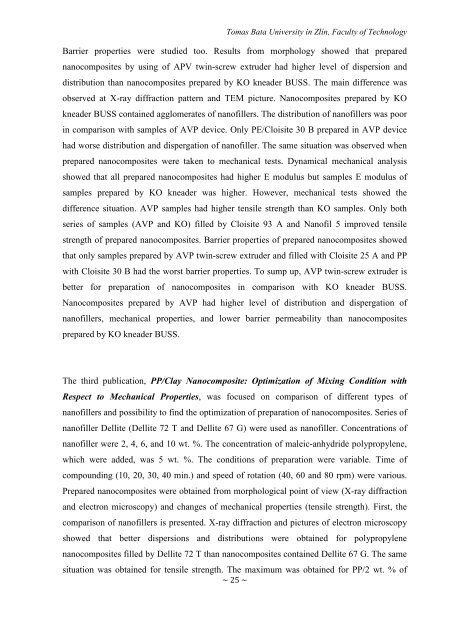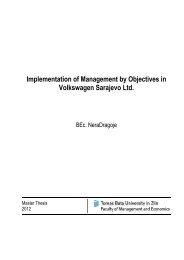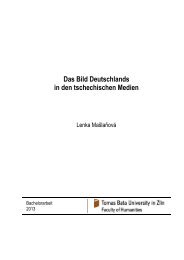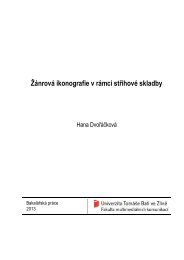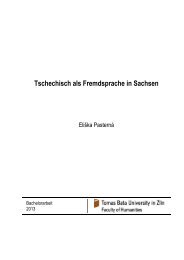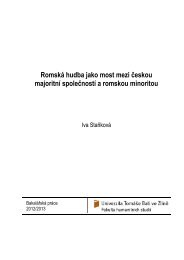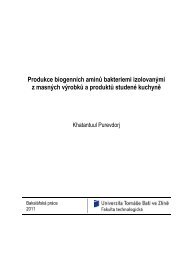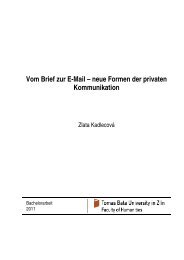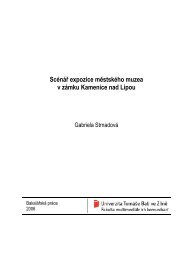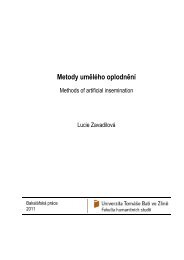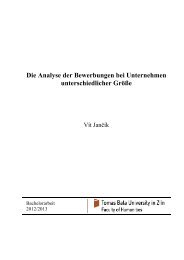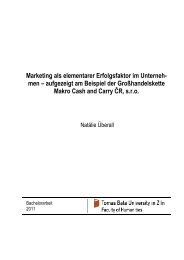The study of using of nanofillers in polyolefinic matrix - DSpace UTB
The study of using of nanofillers in polyolefinic matrix - DSpace UTB
The study of using of nanofillers in polyolefinic matrix - DSpace UTB
You also want an ePaper? Increase the reach of your titles
YUMPU automatically turns print PDFs into web optimized ePapers that Google loves.
Tomas Bata University <strong>in</strong> Zlín, Faculty <strong>of</strong> Technology<br />
Barrier properties were studied too. Results from morphology showed that prepared<br />
nanocomposites by <strong>us<strong>in</strong>g</strong> <strong>of</strong> APV tw<strong>in</strong>-screw extruder had higher level <strong>of</strong> dispersion and<br />
distribution than nanocomposites prepared by KO kneader BUSS. <strong>The</strong> ma<strong>in</strong> difference was<br />
observed at X-ray diffraction pattern and TEM picture. Nanocomposites prepared by KO<br />
kneader BUSS conta<strong>in</strong>ed agglomerates <strong>of</strong> nan<strong>of</strong>illers. <strong>The</strong> distribution <strong>of</strong> nan<strong>of</strong>illers was poor<br />
<strong>in</strong> comparison with samples <strong>of</strong> AVP device. Only PE/Cloisite 30 B prepared <strong>in</strong> AVP device<br />
had worse distribution and dispergation <strong>of</strong> nan<strong>of</strong>iller. <strong>The</strong> same situation was observed when<br />
prepared nanocomposites were taken to mechanical tests. Dynamical mechanical analysis<br />
showed that all prepared nanocomposites had higher E modulus but samples E modulus <strong>of</strong><br />
samples prepared by KO kneader was higher. However, mechanical tests showed the<br />
difference situation. AVP samples had higher tensile strength than KO samples. Only both<br />
series <strong>of</strong> samples (AVP and KO) filled by Cloisite 93 A and Nan<strong>of</strong>il 5 improved tensile<br />
strength <strong>of</strong> prepared nanocomposites. Barrier properties <strong>of</strong> prepared nanocomposites showed<br />
that only samples prepared by AVP tw<strong>in</strong>-screw extruder and filled with Cloisite 25 A and PP<br />
with Cloisite 30 B had the worst barrier properties. To sump up, AVP tw<strong>in</strong>-screw extruder is<br />
better for preparation <strong>of</strong> nanocomposites <strong>in</strong> comparison with KO kneader BUSS.<br />
Nanocomposites prepared by AVP had higher level <strong>of</strong> distribution and dispergation <strong>of</strong><br />
nan<strong>of</strong>illers, mechanical properties, and lower barrier permeability than nanocomposites<br />
prepared by KO kneader BUSS.<br />
<strong>The</strong> third publication, PP/Clay Nanocomposite: Optimization <strong>of</strong> Mix<strong>in</strong>g Condition with<br />
Respect to Mechanical Properties, was focused on comparison <strong>of</strong> different types <strong>of</strong><br />
nan<strong>of</strong>illers and possibility to f<strong>in</strong>d the optimization <strong>of</strong> preparation <strong>of</strong> nanocomposites. Series <strong>of</strong><br />
nan<strong>of</strong>iller Dellite (Dellite 72 T and Dellite 67 G) were used as nan<strong>of</strong>iller. Concentrations <strong>of</strong><br />
nan<strong>of</strong>iller were 2, 4, 6, and 10 wt. %. <strong>The</strong> concentration <strong>of</strong> maleic-anhydride polypropylene,<br />
which were added, was 5 wt. %. <strong>The</strong> conditions <strong>of</strong> preparation were variable. Time <strong>of</strong><br />
compound<strong>in</strong>g (10, 20, 30, 40 m<strong>in</strong>.) and speed <strong>of</strong> rotation (40, 60 and 80 rpm) were various.<br />
Prepared nanocomposites were obta<strong>in</strong>ed from morphological po<strong>in</strong>t <strong>of</strong> view (X-ray diffraction<br />
and electron microscopy) and changes <strong>of</strong> mechanical properties (tensile strength). First, the<br />
comparison <strong>of</strong> nan<strong>of</strong>illers is presented. X-ray diffraction and pictures <strong>of</strong> electron microscopy<br />
showed that better dispersions and distributions were obta<strong>in</strong>ed for polypropylene<br />
nanocomposites filled by Dellite 72 T than nanocomposites conta<strong>in</strong>ed Dellite 67 G. <strong>The</strong> same<br />
situation was obta<strong>in</strong>ed for tensile strength. <strong>The</strong> maximum was obta<strong>in</strong>ed for PP/2 wt. % <strong>of</strong><br />
~ 25 ~


